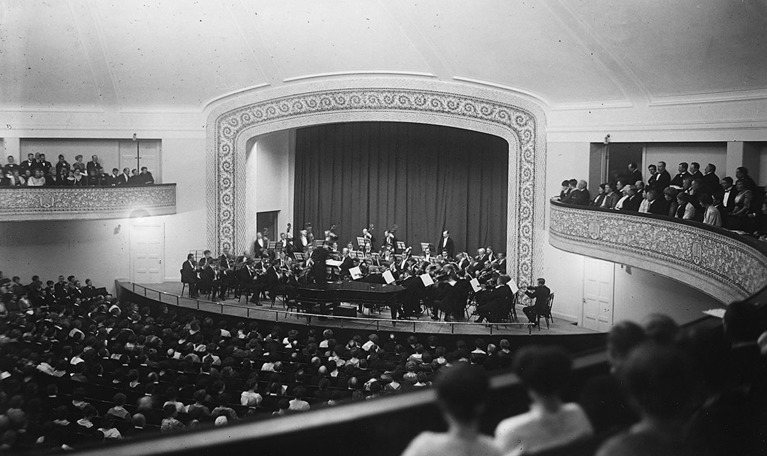Georg Schnéevoigt

A renovated gas holder that also served as a movie theatre, Auditorium in Norra Bantorget, was the orchestra’s home from 1914–26.
Georg Schnéevoigt was chief conductor from 1915–24. He conducted a total of 391 concerts with the orchestra.
In 1914, the orchestra became a full-time ensemble after a few years in which operations languished. In November 1913, auditions were held in Hotell Rydberg for engagement with the Stockholm Concert Society, with the aim of hiring 60–70 members.
Meanwhile, a new, bigger concert space had been located: the so-called Industripalatset (Industrial Palace), now known as Vinterpalatset (Winter Palace) in Norra Bantorget had nearly 1,800 seats. When the Stockholm Concert Society held its first concert there on 15 January 1914, the space had been named Auditorium, and it would be the orchestra’s home until Konserthuset opened in 1926.
The programme that evening: Beethoven’s Symphony No. 7 and Piano Concerto No. 5 (with Wilhelm Stenhammar performing the solo), and Wagner’s prelude to the Mastersingers of Nuremberg. At the time of the reboot, the orchestra was primarily conducted by German Hans Seeber van der Floe. He was then replaced by German Erich Ochs. Wilhelm Peterson-Berger conducted the premiere performance of his own Symphony No. 2 on 19 February 1914.
Founder and initiator Tor Aulin died on 1 March 1914 and the orchestra performed at his funeral service.
In the winter of 1914, Erich Ochs left and Finnish Georg Schnéevoigt debuted with the orchestra on 17 December 1914, in a programme with music by Brahms and Richard Strauss. Georg Schnéevoigt, whose first language was Swedish, had studied in Helsinki, Leipzig and Brussels. Early in his career, he was active throughout Europe, and had seen major success as Felix Weingartner’s successor in Munich in 1904–08.
It is true that Schnéevoigt was notorious for his temperament and certain dictatorial tendencies, but he was also appreciated for his interpretations of the Romantic repertoire – and above all, he was a friend of and expert on the music of his fellow countryman, Sibelius. Among other things, he was responsible for the premiere performance of Sibelius’ Symphony No. 6.
In spring 1915, Schnéevoigt led the orchestra in a total of 15 concerts. Meanwhile, Nils Grevillius was hired as second conductor (and remained in the role until 1920) and participated in 22 concerts.
In the seasons that followed, Schnéevoigt took on more and more responsibility as chief conductor – or “first conductor”, as the position was known at the time. In some seasons, he conducted nearly 50 concerts, while Nils Grevillius often conducted about half as many. At the same time, Schnéevoigt was also chief conductor of the Helsinki Philharmonic Orchestra, which was established in 1914.
The orchestra’s first tour abroad took them to Oslo in January 1917, and they also guest performed in Örebro and Karlstad under Schnéevoigt’s baton. In the 1917–18 season, the orchestra gave 75 concerts, including two school concerts. Schnéevoigt conducted most of them. At the end of the season, Carl Nielsen also conducted the orchestra in a performance of his own violin concerto.
A certain decline in attendance became apparent after the peak in the 1917–18 season (about 118,400 attendees). In spring 1920, the orchestra began negotiations with Wilhelm Furtwängler for potential employment. Schnéevoigt strongly opposed the ideas; the plans were abandoned and it all ended with the board having to resign; Schnéevoigt stayed on as chief conductor.
The orchestra also went through a financial crisis in the early 1920s, but was saved through the government’s allocation of lottery funds and a guaranteed annual grant from the City of Stockholm. In 1923, the decision was taken to build Konserthuset. In the summer of 1923, the old building on Hötorget where the new one would be was demolished.
Notable guest conductors in these years included Jean Sibelius – Stockholm Concert Society gave the premiere performance of Symphony No. 7 with the composer himself in Auditorium on 24 March 1924. The orchestra was also conducted by Carl Nielsen, Richard Strauss, Kurt Atterberg, Pierre Monteux, Wilhelm Furtwängler and Siegfried Wagner (who conducted music by his father, Richard).
Georg Schnéevoigt was chief conductor from 1915–24 and was considered to be a leading conductor of his time. During that period, he regularly conducted music by Beethoven, Sibelius, Wagner, Brahms and Tchaikovsky, as well as plenty of Swedish music – including premiere performances of pieces by Kurt Atterberg, Oskar Lindberg, Natanael Berg, Hugo Alfvén, Emil Sjögren and Ture Rangström.
